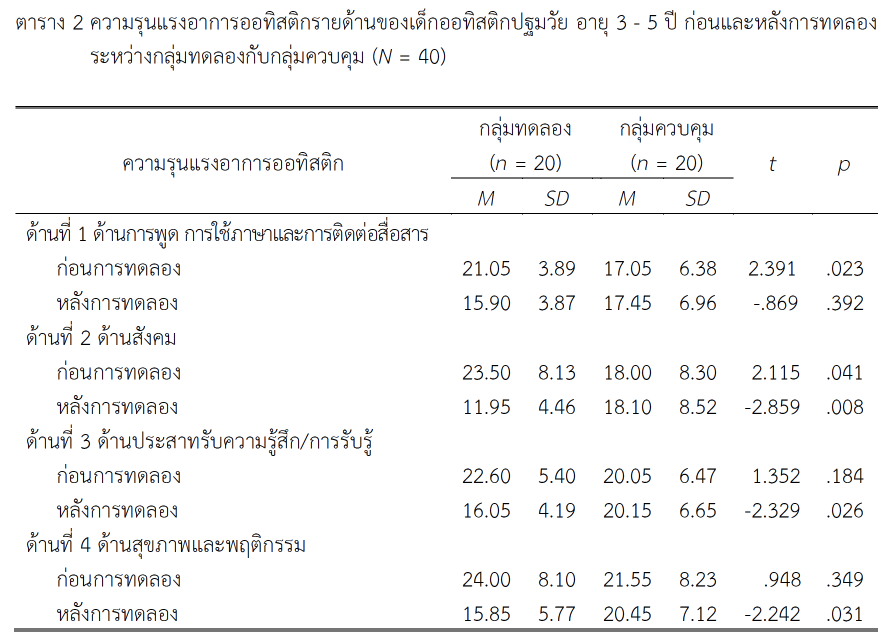THE DEVELOPMENT OF PERSONALIZED CARE MODEL FOR ENHANCING DEVELOPMENTAL SKILLS IN EARLY CHILDHOOD WITH LOW-FUNCTIONING AUTISM
Keywords:
developmental skills enhancing, early childhood with autismAbstract
This research and development study aimed to assess the situation, develop a personalized care model, and evaluate its effectiveness for early childhood with low-functioning autism. The sample included 1) 40 children with low-functioning autism, aged 3-5 years, 2) 40 parents of children with early childhood autism, and 3) 6 professional nurses. Research tools included 1) a group conversation data recording form, 2) an individualized care guide to enhance developmental skills in early childhood with low-functioning autism, 3) a guide to enhance developmental skills in early childhood with low-functioning autism, 4) an assessment form for the severity of autism symptoms in children, 5) an assessment form for the knowledge and skills of caregivers, and 6) a nurse satisfaction assessment form. The content validity indices for tools 2-6 were .84, .81, .97, .86, and .96, respectively. The reliability of the assessing tool for the severity of autism symptoms in children is .93 and for the assessment form for the knowledge and skills of caregivers, it is .84. Data analysis involves content analysis, descriptive statistics, and t-tests.
The findings revealed that:
1. The situation of caring and enhancing developmental skills in early childhood with low-functioning autism followed an inpatient caring program and responded to the problems and needs of children with autism and their families. However, it lacked specificity in addressing individual problems, and the duration of developmental promotion needed to be extended to at least 3-4 rounds for evaluation every 3 months. Moreover, the caregiver's involvement in the care of children with autism lacked a clear model.
2. The personalized care model for enhancing developmental skills in early childhood with low-functioning autism consisted of 5 individual nursing process steps.
3. The results of the effectiveness of the personalized care model showed that the average severity of autism symptoms in the experimental group, which received care according to the personalized care model, differed from that in the control group, which received care according to the regular service program, both before and after the experiment, with statistical significance at the .05 level. Moreover, the knowledge and skills of caregivers in caring for early childhood with autism were significantly higher after the experiment, with statistical significance at the .05 level, and nurse satisfaction with the use of the personalized care model was at the highest level.
Downloads
References
American Psychiatric Association. (2013). Diagnostic and statistical manual of mental disorders (DSM-5®) (5th ed.). Washington, D.C.: American Psychiatric.
Chuthapisith, J. (2018). Autism spectrum disorder. In S. Sutchritpongsa, R. Roongpraiwan, T. Hansakunachai, B. Benjasuwantep, A. Fuengfoo, J. Chuthapisith, & P. Rojmahamongkol (Eds.). Textbook of developmental and behavioral pediatrics (pp. 587-598). Bangkok: P.A.Living.
Glasper, A. (2020). Strategies to ensure that all patients have a personalized nursing care plan. British Journal of Nursing, 29(1), 62-63.
Green, J., Charman, T., McConachie, H., Aldred, C., Slonims, V., Howlin, P., . . . Pickles, A. (2010). Parent-mediated communication-focused treatment in children with autism (PACT): A randomised controlled trial. The Lancet, 375(9732), 2152-2160.
Howlin, P., Goode, S., Hutton, J., & Rutter, M. (2004). Adult outcome for children with autism. Journal of Child Psychology and Allied Disciplines Psychiatry, 45, 212–29. https://doi.org/10.1111/j.1469-7610.2004.00215.x
Ma, J., Rosas, L. G., & Lv, N. (2016). Precision lifestyle medicine: A new frontier in the science of behavior change and population health. American Journal of Preventive Medicine, 50(3), 395-397.
Muangmolmaneerut, W., & Tungpunkom, P. (2006). The relationship between selected factors, social support, and dependent care agency among mothers of autistic children (Master of nursing science, mental health and psychiatric nursing). Chiang Mai University, Chiang Mai.
Munro, C. L., & Savel, R. H. (2016). The promise of personalized care in the intensive care unit. American Journal of Critical Care, 25(5), 388-390.
NHS England. (2019). NHS long term plan. Retrieved from https://www.longtermplan.nhs.uk/wp-content/uploads/2019/08/nhs-long-term-plan-version-1.2.pdf
Potter, P. A., Perry, A. G., Hall, A., & Stockert, P. A. (2017). Fundamentals of nursing (9th ed.). Mosby Elsevier.
Punphong, S. (2018). The effect of enhancing family caregiving ability program on autistic symptoms among autistic preschoolers (Master of nursing science program, nursing science). Faculty of Nursing Chulalongkorn University, Bangkok, Pathumwan.
Rajanukul institute. Quality Improvement Division. (2022). Self-assessment report 2020. Bangkok: institute.
Rajanukul institute, Community of Practices (CoPs) of autism spectrum disorder. (2021). Intervention of autism spectrum disorder. Bangkok: institute.
Rimland, B., & Edelson, S. M. (2000). Autism treatment evaluation checklist. Retrieved from https://www.autism.com/atec/2000.
Scottish Intercollegiate Guidelines Network (SIGN). (2007). Assessment, diagnosis and clinical interventions for children and young people with autism spectrum disorders. Edinburgh: SIGN 98.
Sirirutraykha, T. (2022). Autism. Retrieved from https://www.happyhomeclinic.com/au21-autism-fag.html
Thongpetch, U., Yunibhand, J., & Choomchit, S. (2019). Effects of early nursing intervention on symptom severity of preschool children with autism. Thai Journal of Nursing and Midwifery Practice, 6(1), 19-35.
van Meijel, B., Gamel, C., van Swieten-Duijfjes, B., & Grypdonck, M. H. (2004). The development of evidence-based nursing interventions: Methodological considerations. Journal of Advanced Nursing, 48(1), 84-92.
Weissman, L., & Bridgemohan, C. (2012). Autism spectrum disorders in children and adolescents: Pharmacologic interventions. In UpToDate, M. M. Torchia (Ed.), UpToDate. Waltham, MA.

Downloads
Published
How to Cite
Issue
Section
License
Copyright (c) 2023 JOURNAL OF THE POLICE NURSES

This work is licensed under a Creative Commons Attribution-NonCommercial-NoDerivatives 4.0 International License.
ผลงานที่ได้ตีพิมพ์แล้วจะเป็นลิขสิทธิ์ของวารสารพยาบาลตำรวจ














